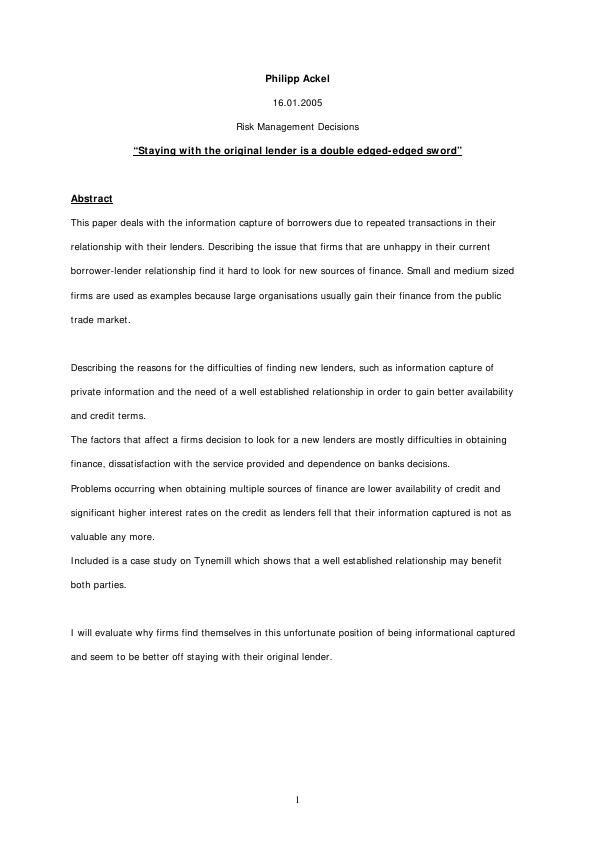This paper deals with the information capture of borrowers due to repeated transactions in their relationship with their lenders. Describing the issue that firms, that are unhappy in their current borrower-lender relationship find it hard to look for new sources of finance. Small and medium sized firms are used as examples because large organisations usually gain their finance from the public trade market.
Describing the reasons for the difficulties of finding new lenders, such as information capture of private information and the need of a well established relationship in order to gain better availability and credit terms.
The factors that affect a firms decision to look for a new lenders are mostly difficulties in obtaining finance, dissatisfaction with the service provided and dependence on banks decisions.
Problems occurring when obtaining multiple sources of finance are lower availability of credit and significant higher interest rates on the credit as lenders fell that their information captured is not as valuable any more.
Included is a case study on Tynemill which shows that a well established relationship may benefit both parties.
I will evaluate why firms find themselves in this unfortunate position of being informational captured and seem to be better off staying with their original lender.
Inhaltsverzeichnis (Table of Contents)
- Abstract
- Introduction
- Difficulties with Switching Lenders
- Private Information
- Lender-borrower Relationship
- Reasons for Switching Lenders
- Problems occurring when Switching Lenders
- Case study on Tynemill Ltd
- Recommendations
- Conclusion
- References
Zielsetzung und Themenschwerpunkte (Objectives and Key Themes)
This paper explores the challenges faced by small and medium-sized firms (SMFs) when attempting to switch lenders. It examines the factors contributing to these difficulties, particularly focusing on the importance of information capture and the lender-borrower relationship. The paper also analyzes the reasons why firms might consider switching lenders, including issues with obtaining financing, dissatisfaction with existing services, and dependence on banks. Additionally, the paper delves into the potential problems associated with multiple sources of finance, such as higher interest rates and reduced credit availability.
- Information Capture and its Impact on Lender Decisions
- The Role of the Lender-Borrower Relationship in Securing Finance
- Challenges and Considerations of Switching Lenders
- Reasons for Firms to Consider Switching Lenders
- Consequences of Multiple Sources of Finance for SMFs
Zusammenfassung der Kapitel (Chapter Summaries)
- Introduction: Introduces the issue of SMFs struggling to switch lenders, emphasizing the importance of information capture and the lender-borrower relationship.
- Difficulties with Switching Lenders: Examines the two primary reasons why SMFs find it difficult to switch lenders: the lack of an established relationship with potential lenders and the private information gathered during an existing relationship. The section explores how private information, including credit performance and market data, influences lender decisions regarding creditworthiness.
- Reasons for Switching Lenders: Investigates the main drivers behind firms' decisions to consider switching lenders, such as difficulties obtaining adequate financing, dissatisfaction with existing services, and the desire for more flexible financial arrangements.
- Problems occurring when Switching Lenders: Addresses the potential issues that arise when firms switch lenders, including reduced credit availability and significantly higher interest rates. These issues stem from lenders' perceptions of decreased value in their captured information when a firm uses multiple sources of finance.
- Case study on Tynemill Ltd: This chapter presents a specific case study of Tynemill Ltd to illustrate how a well-established relationship between lender and borrower can benefit both parties.
Schlüsselwörter (Keywords)
This paper focuses on the key concepts of information capture, lender-borrower relationship, risk management, creditworthiness, and switching lenders in the context of small and medium-sized firms (SMFs). It examines the difficulties faced by these firms when seeking alternative lenders and explores the factors influencing their decisions to switch. Key themes include the importance of established relationships, the challenges of transferring private information, and the potential consequences of multiple sources of finance.
- Citar trabajo
- Philipp Ackel (Autor), 2005, Staying with the original lender is a double-edged sword, Múnich, GRIN Verlag, https://www.grin.com/document/78051


